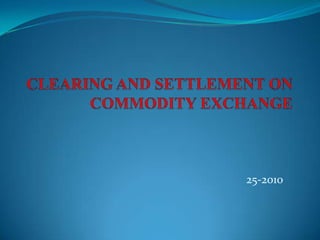
Risks and Settlement in Commodity Markets
- 1. 25-2010
- 2. Commodity markets are markets where raw or primary products are exchanged. These raw commodities are traded on regulated commodities exchanges, in which they are bought and sold
- 3. RISK IN COMMODITY MARKET Refers to the uncertainties of future market values and of the size of the future income, caused by the fluctuation in the prices of commodities Commodity future contracts are standardised in terms of quality of the underlying commodity LIQUIDITY: given that the features of futures contracts are standardised by the exchange allowing them to trade on the exchange, the contracts are liquid and there is always a ready market for them. Absence of counter party risk: PRICE DISCOVERY: the electronic trading platform provided by the commodity exchange combined with liquidity and risk free trading encourages wider participation, ensuring larger volumes and minimised price manipulation.
- 4. Market risk- Risk of loss suffered by buyers or sellers on account of adverse event of prices Credit risk-It is very low or almost zero because the exchange takes on the responsibility for the performance Operational risk arising out of some operational difficulties Legal risk is risk coming from legal objections that might be raised since the exchange regulatory framework might disallow some activities
- 5. COMMODITY CLEARING HOUSE Clearing house can be defined as entity which is different from the exchange, The clearing house is responsible for keeping records
- 6. Clearing house Clearing house acts as a seller to all buyers and a buyer to all sellers. Each day of trading all exchange members must report their buys and sell to the clearing house. The clearing house then ensures that financial settlement from all buyers and sellers is made to the clearing house. The clearing house guarantees all contracts by requiring that the participants maintain cash deposits called margins or margins money. As soon as a contract is processed by the clearing house the buyer and seller of the contract will have a contract with the clearing house instead of counter party with their original trade
- 7. Margining method Margin money- Margin money is like a security deposit or insurance against possible future loss of value. The aim of margin money like good faith money is to minimise the risk To safeguard the integrity of the market and its own interest, the exchange imposes the margin money New contracts on the first day are assigned on base rate Settlement price based on average of the last trades of the trading day Due date rate calculated based on average of the last few days closing prices
- 8. Initial margin initial margin is the amount to be deposited by the market participants in their margin account with the clearing house before they can place buy or sell order of a futures contract. VARIATION OR MARK TO MARKET MARGIN: Margin is worked out on the difference between the closing rate and rate of the contract It helps to protect the interest of the exchange
- 9. Additional (volatility) margin: Volatility margin is extra margin imposed by exchange on the buyer and the seller in the event of sudden increase in volatility of prices of the underlying in the market. Tender period margin: Extra margin imposed on the contracts during concluding phase Maintenance margin It is the minimum amount of margin that is required to be held in the margin account relative to the futures position held
- 10. OTHER RISK CONTAINMENT MEASURES USED BY EXCHANGES Guarantee for Settlements The exchange only ensures proper correlation between prices in the spot and futures markets and guarantees the performance of the contracts by analysing the risks on continuous basis. The Settlement Guarantee Fund (SGF), also called the Trade Guarantee Fund (TGF) Objective of the funds are To guarantee settlement of bonafide transactions To inculcate confidence in the minds of market participants To protect the interest of investors
- 11. Price limit and circuit breakers procedures to control overreactions in times of serious market volatility these mechanisms are known as circuit breakers and price limits. Price limit affect the way trading in the future market And circuit breaker deals with whether trading will be halted temporarily, or stopped together entirely
- 12. Settlement process Physical delivery Cash settlement Based on the underlying spot price
- 14. WAREHOUSING AND WAREHOUSE RECEIPTS Warehousing provides critical logistic support to the commodity sector If the trade is expected to be settled by way of delivery of the commodity the clearing house of the commodity exchange warehouse receipts from the seller instead of actual commodities and pass such warehouse receipts over to the buyer.
- 15. Warehouse receipts (WRs) are title documents issued by warehouse to depositors against the commodities deposited in the warehouse The Warehousing (Development and Regulation) Act 2007 Negotiable warehouse receipts (NWRS) this help the farmers to avoid the distress sale of their produce by ensuring them access to finance against their produced stored
- 16. Dematerialisation of warehouse receipts Act prescribes the form and the manner of registration of warehouse and issue of NWRs in electronic form Disadvantages of physical warehouse receipts: 1. Need for splitting the warehouse receipts in case the depositor has an obligation to transfer only a part of the commodity 2.Need to move the warehouse receipt from one place to another with risk of theft, mutilation etc. 3. Risk of forgery
- 17. DELIVERY PROCESS FUTURE SPOT TRADE TRADE
- 18. DELIVERY TYPES BOTH OPTION- delivery of the commodity will take place only if both buyer and seller give their intention to give/take delivery before the expiry of the contract. SELLERS OPTION delivery is based on seller’s intention. The buyer has to take delivery on compulsory basis that has been allocated to him by the Exchange.
- 19. COMPULSORY DELIVERY All the open positions on the date of expiry of the contract shall result in delivery. The commodities will be compulsorily delivered either by giving delivery or taking delivery